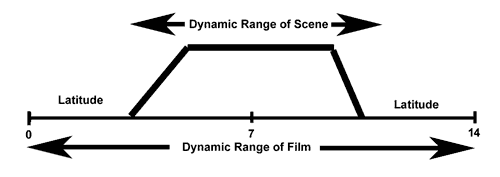Film Dynamic Range and Latitude
Dynamic Range
The dynamic range of film is the ratio between the largest and smallest values of light intensity that the film can handle. Most negative film has around 13 stops of dynamic range. A stop is the doubling of the light intensity. This means that the highest brightness it can handle is 8192 times the lowest it can handle. This compares favourable with digital where only high end units can top that.
Latitude
When you frame a scene, it will also have dynamic range. For instance, a scene on a foggy day may only have a dynamic range of 7 stops whereas if you are pointing the camera towards a window from inside a room, the dynamic range between the room interior and the scene outside may be 12 stops. The dynamic range of the scene needs to be fitted into the dynamic range of the film by choosing the correct exposure value. As you can appreciate, it will be easier to ensure that the whole dynamic range of the foggy day is accommodated by the film. The ease by which you can accommodate the scene's dynamic range on film is called latitude.

It is generally accepted that it is possible to overexpose film by at least 3 stops or underexpose by 1 stop and still get a useable image. Colour Films like Kodak Portra have a documented useable range of +5 stops to -2 stops whereas black and white Ilford FP4 Plus is robust and will give usable results even if it is overexposed by as much as six stops, or underexposed by two stops. However, to be safe, it is better to limit overexposure to +3 and underexposure to -1. As you can see, it is better to overexpose than to underexpose negative film.
Let's have a look at how all this affects making images with a Kodak Beau Brownie. If you don't want to bother with an exposure meter, follow the guide below. It is based on the 'Sunny 16' rule. The tables below assume the shutter speed is about 1/40s. The Beau Brownie has 3 aperture values available controled by a metal tab. Aperture values are:- f/11 (Tab Down); f/16 (Tab Middle); f/22 (Tab Up). If you are not sure about the light level, err on the side of overexposure - i.e. assume the lower light level.
The tables also assume that the sun is at least 30 degrees above the horizon - that's 10am - 5pm on a summers day in the UK. The tables below will hold good for any three aperture Brownie camera with a fixed speed of between 1/40s and 1/60s
Beau Brownie using ISO 100 Film
| Weather Conditions | Shadow Detail | Aperture | Exposure |
|---|---|---|---|
 Sunny SunnySnow/Sand | Dark with sharp edges | Tab Up f/22 | +1 Stop Overexposed Acceptable |
 Sunny Sunny | Distinct | Tab Up f/22 | Good |
 Slight Overcast Slight Overcast | Soft around edges | Tab Middle f/16 | Good |
 Overcast Overcast | Barely visible | Tab Down f/11 | Good |
 Heavy Overcast Heavy Overcast | None | Tab Down f/11 | -1 Stop Underexposed Acceptable |
 Open Shade Open Shade/Sunset | None | Tab Down f/11 | -2 Stops Underexposed Not Acceptable |
Beau Brownie using ISO 400 Film
| Weather Conditions | Shadow Detail | Aperture | Exposure |
|---|---|---|---|
 Sunny SunnySnow/Sand | Dark with sharp edges | Tab Up f/22 | +3 Stops Overexposed Acceptable |
 Sunny Sunny | Distinct | Tab Up f/22 | +2 Stops Overexposed Acceptable |
 Slight Overcast Slight Overcast | Soft around edges | Tab Up f/22 | +1 Stop Overexposed Acceptable |
 Overcast Overcast | Barely visible | Tab Up f/22 | Good |
 Heavy Overcast Heavy Overcast | None | Tab Middle f/16 | Good |
 Open Shade Open Shade/Sunset | None | Tab Down f/11 | Good |
Good News
So using old film cameras isn't as difficult as some make out. Just wack in a film and snap away! Remember that following exposure information in the camera manual for simple vintage cameras using ISO 100 film will lead to overexposure by 1 to 2 stops. This is because the exposure recomendations are based on the speed of old film. However, overexposing by 1 or 2 stops will still give acceptable and satisfying results.
